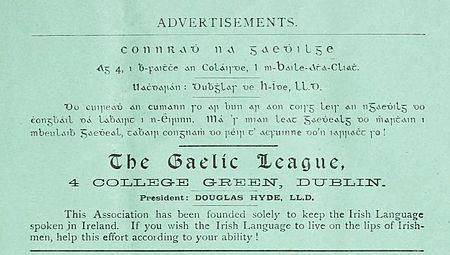31 July 1893: The Foundation of the Gaelic League/ Conradh na Gaeilge on this day. It was founded at 9 Lower O'Connell St., Dublin, on 31 July 1893, with the purpose of keeping the Irish language spoken in Ireland at a time when census returns indicated that the number of native Irish-speakers was in rapid decline as a consequence of high emigration and the abandonment of the language in favour of English.
The idea came from a proposal of Eoin McNeill in a letter to his colleagues in June of that year:
It is proposed to arrange by agreement among persons interested in the preservation of Gaelic as a spoken language for a preliminary consultative gathering of an informal kind to initiate practical steps towards the formation on the lines indicated in a recent article in the Gaelic Journal or otherwise as may be determined of an organisation to maintain and promote the use of Gaelic as a spoken language in Ireland.
‘Unlike earlier movements concerned with antiquarian and folkloric studies, the League sought to revive Irish as a spoken and literary movement. It ran language classes and Irish–speaking social gatherings, including from 1897 a national festival, an tOireachtas and published a newspaper, An Claidheamh Soluis and sponsored the publication of contemporary verse and prose. Public awareness of its work was heightened in 1899 when it opposed attempts, headed by John Pentland Mahaffy, provost of Trinity College Dublin, to have Irish removed from the Intermediate school syllabus. During 1908-9, it campaigned successfully to have Irish made a compulsory matriculation subject in the new National University of Ireland.
The membership of the League was drawn mainly from the urban lower middle classes of English–speaking Ireland. As such, it testifies, like the GAA, to the acute need for cultural roots felt by many at the end of several decades of exceptionally rapid social change. There was an inevitable tendency to idealise the culture and way of life of the surviving Gaeltacht areas. The leadership of the League, notably Hyde, insisted that it should be non-political and the movement initially attracted significant support from Protestants and Unionists. However, given its obvious political overtones, there were differences between nationalists and Unionists. League members took a prominent part in the 1916 rising and in the subsequent growth of Sinn Féin and the IRA.'
http://multitext.ucc.ie/d/Irish_Ireland

No comments:
Post a Comment